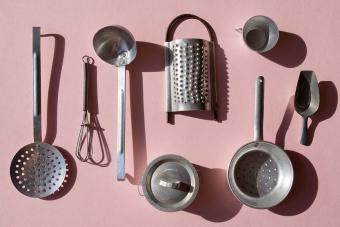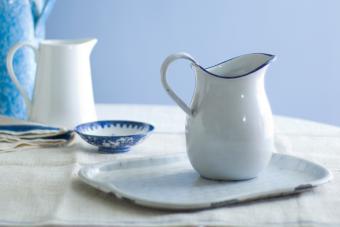
From hand crank mixers to butter molds, there are lots of antique kitchen tools that aren't used anymore. Even some of the familiar favorites, such as rolling pins, can come in all different kinds of designs. Learning to identify vintage kitchen tools is fun, and it can come in handy next time you're shopping at an antique store or thrift shop.
How to Identify Vintage Kitchen Tools
If you have a kitchen tool and aren't sure what it is, there are a few steps you can take to solve the mystery. Get it out and do a little research with these simple steps for identification.
1. Note Important Characteristics
First, examine the antique kitchen tool to see what you can tell from looking at it. The appearance can give you some information about the purpose of this utensil. Ask yourself a few questions:
- Does it have a handle?
- Are there moving parts? If so, what do they seem to do?
- Is it sharp?
- How big is it?
- Does it remind you of any modern kitchen tools you've seen?
2. Pay Attention to Materials Used in Antique Kitchen Tools

While your observations about the utensil may help you identify its purpose, the materials used can help you get a sense of its age. These are some of the materials manufacturers used in antique kitchen tools:
- Copper - Copper kitchen tools were common in the late 19th century. They tend to tarnish and may appear dull brown or greenish in color.
- Tin - Peddlers and stores sold inexpensive tin utensils throughout the late 19th and early 20th century.
- Iron - Pieces showing spots or even large sections of rust may be made of iron, a material popular for kitchen utensils around the turn of the 20th century.
- Wood - Antique wooden kitchen tools may be painted or left plain. Some items may have wooden handles, and many butter molds were made entirely of wood during the 19th century.
- Plastic - Plastics became popular in the early to mid-20th century, and it's common to find plastic handles and components on vintage kitchen tools from this time period.
- Glass - Certain utensils, such as citrus juicers and measuring cups, may be made of glass. These were especially popular during the early and mid-20th century.
- Aluminum - Aluminum became very popular during the early part of the 20th century, and it remained popular for many decades.
3. Compare Your Tool to Other Antique Kitchen Tools
If you are struggling to identify a vintage kitchen tool, compare it to others you may have seen. You can do this by looking at photos online, searching listings in online and antique shops, and browsing at your local antique stores.
16 Antique Kitchen Tools You Might Have
Kitchens are full of specialized gadgets, but knowing a few of them can help you identify kitchen utensils you might have. These are a few common and uncommon antique kitchen tools you may have in your cupboards or drawers.
Spatulas and Spreaders

These handled kitchen utensils are easy to identify because of their flat shape. Spatulas have been around for centuries, and you'll see vintage and antique examples. Some are slotted, which means they have narrow slots cut through the flat surface for separating juices or sauces from something you are scooping up.
Vintage Whisks

Available in a wide variety of sizes, whisks generally have a familiar shape and are usually made of wire. Some are a spiral or coil of wire instead of pieces arranged in vertical lines. Vintage whisks can have metal, wooden, or plastic handles.
Antique Tongs

From tiny sugar cube tongs that sometimes feature claw or bird foot ends to larger hinged tongs for picking up blocks of ice, these antique kitchen tools come in all different shapes and sizes. You can always recognize them by the way they work, however. If you pinch them together to pick something up, you know you have a pair.
Ladles and Dippers

Ladles have been a part of many home kitchens for centuries. They were made of silver, copper, wood, and other materials. You'll even see glass examples that are part of antique punch bowl sets.
Wooden Spoons

Still an important part of many home kitchens, wooden spoons have been around for hundreds of years. The oldest examples are not uniform in shape and may show signs of hand carving. These don't hold up well over time, however, so very old examples are rare.
Measuring Cups

Made of glass, metal, and sometimes plastic, measuring cups help cooks get accurate amounts of various ingredients. Vintage measuring cups aren't always cup-shaped; some may resemble pitchers or small scoops. Look for signs of hand soldering on metal examples and early glass production methods on glass ones.
Measuring Spoons

Vintage measuring spoons are often made of metal, and some have wooden handles. You can identify them because they are usually marked with the measurement or its abbreviation, such as "tsp" or "teaspoon."
Vintage Colanders

Colanders or strainers help separate solid food from water, broth, oil, and other liquids. They look like bowls with lots of small holes in them. Vintage examples may be enameled in various colors, or they may simply be metal.
Antique and Vintage Sieves

While colanders tend to have larger holes, sieves are usually made of mesh and have a metal frame. Some have wood or plastic handles, depending on their age. They come in various sizes, from little ones that can sit on top of a drinking glass to large ones made for resting in a pot.
Cookie Cutters

Cookie cutters have been around for a long time, and it's common to find vintage and antique examples in thrift stores and antique shops. Many vintage cookie cutters date to the post-WWII period when they became extremely popular, although some can be much older.
Pastry Blenders

A little-known antique kitchen tool is the pastry blender. These came in a few different styles, including large forks with pointed tines for blending dough as well as a wood or plastic handles with several metal "hoops" connected to it. These vintage baking tools made it easy to mix pie crust and other types of dough.
Melon Baller

This little kitchen tool has a very specific purpose. The tiny rounded scoops are made to create perfect round balls of melon. The handle can be wood or plastic or metal, and these were especially popular during the middle of the 20th century.
Cheese Grater

Graters, which aren't always used for cheese, have been around for a long time. They may have started as nail holes punched in metal, but during the late 19th century and throughout the 20th century, they were made by machine. You'll find them made of metal with plastic, metal, or wood frames.
Hand Mixer

Before the electric mixer, home cooks used crank hand mixers to beat eggs, combine ingredients, and whip cream. You can still find antique hand mixers in thrift stores, vintage shops, and online.
Ice Cream Scoop

Dating back to the late 19th century, ice cream scoops have become an important part of many kitchens. You'll see vintage ones with wooden, metal, or plastic handles, and some also have a lever that helps remove the ice cream from the scoop.
Butter Molds

Used to press butter into attractive shapes, butter molds have been around for a long time. Many of these antique kitchen tools are made of wood, carved with intricate designs. They can work in different ways. Some have a plunger that releases the shaped butter, and with others, the home cook must pry the butter out of the mold. You'll see these attractive little treasures at antique stores and online.
Collect Vintage Kitchen Tools
Whether you're outfitting your kitchen for off-the-grid functionality, decorating with vintage utensils for some old fashioned flair, or simply love knowing what cooks of yesteryear used to make their meals, vintage kitchen tools are fun and fascinating. They also make the basis for an interesting collection, since they're affordable and offer endless variety. For more kitchen collectibles, consider acquiring some vintage Corningware.







